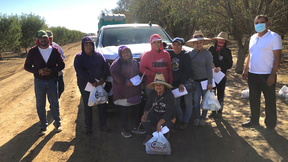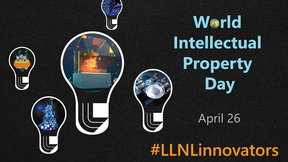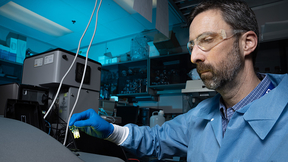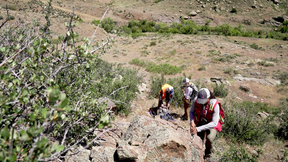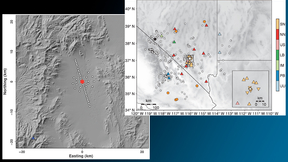Back
Physical and Life Sciences
Accelerating material characterization: Machine learning meets X-ray absorption spectroscopy
Lawrence Livermore National Laboratory (LLNL) scientists have developed a new approach that can rapidly predict the structure and chemical composition of heterogeneous materials. In a new study in ACS Chemistry of Materials, LLNL scientists Wonseok Jeong and Tuan Anh Pham developed a new approach that combines machine learning with X-ray absorption spectroscopy (XANES) to…
GUIDE team develops approach to redesign antibodies against viral pandemics
In a groundbreaking development for addressing future viral pandemics, a multi-institutional team involving Lawrence Livermore National Laboratory (LLNL) researchers has successfully combined an artificial intelligence (AI)-backed platform with supercomputing to redesign and restore the effectiveness of antibodies whose ability to fight viruses has been compromised by…
Lab scientist wins Springer Thesis Award for work in neutrino research
Lawrence Livermore National Laboratory (LLNL) postdoc Sam Hedges has won a 2024 Springer Thesis Award for his work in searching for the elusive neutrino. “I’m honored that my thesis was nominated for this award, and was excited when I found out it had won,” Hedges said. His thesis, “Low Energy Neutrino-Nucleus Interactions at the Spallation Neutron Source," highlights the…
Brain-on-a-chip: Improving 3D neural network analysis
Brain-on-a-chip (BOC) systems are engineered cell-culture models that allow non-invasive, real-time monitoring of electrochemical processes. While newer 3D BOC systems have improved the neuronal viability, neural network activity, drug responses, and resemblance to disease pathology compared to their 2D counterparts, the ability to monitor the functional dynamics of the…
Anti-tumor immune responses in pancreatic cancer
Pancreatic ductal adenocarcinoma (PDAC) is one of the deadliest types of cancer with a limited survival rate of about 10% over five years. In general, by the time a patient presents symptoms, the disease has advanced to a surgically unresectable stage and likely metastasized to other vital organs leading to rapid mortality. Since conventional chemotherapy prolongs patients…
Pett-Ridge selected as a 2024 Ecological Society of America fellow
Lawrence Livermore National Laboratory (LLNL) scientist and head of the Lab’s Carbon Initiative Jennifer Pett-Ridge has been selected as a fellow of the Ecological Society of America (ESA). ESA designates fellows of the society for certain members who have made outstanding contributions to a wide range of fields served by ESA. Pett-Ridge was selected for her work in soil…
Lab assists west Fresno County in clean-energy future
Lawrence Livermore National Laboratory (LLNL) will provide technical assistance to 30 disadvantaged communities in west Fresno County to provide a future in clean-energy projects, including carbon capture and storage. The project is part of the Department of Energy’s Local Energy Action Program (LEAP) that aims to facilitate sustained community-wide economic and…
Celebrating LLNL researchers on World Intellectual Property Day
World Intellectual Property (IP) Day is Friday, April 26. World IP Day shines a light on the important role innovation plays in achieving the United Nations’ (UN) 17 Sustainable Development Goals (SDGs), which aim to create a better future for everyone by protecting the planet. Lawrence Livermore National Laboratory’s (LLNL)’s Innovation and Partnerships Office (IPO) is…
LLNL Pandora SmallSat mission clears major NASA milestone on the path toward launch
Lawrence Livermore National Laboratory’s (LLNL) Pandora SmallSat mission recently passed NASA’s critical design review: a major milestone for the mission to continue its journey toward launch. The Pandora SmallSat mission will study planets beyond our solar system, known as exoplanets, and their stars. “This is a major milestone for the mission and a huge accomplishment…
Going with the flow: research dives into electrodes on energy storage batteries
As a grid-scale energy storage system, flow batteries have gained increasing attention as a means to address the challenges associated with fluctuations and intermittency in renewable energy sources. Vanadium redox flow batteries (VRFBs) have emerged as promising solutions for stationary grid energy storage due to their high efficiency, scalability, safety, near room…
Kurt Dreger’s superpower is protecting workers
Kurt Dreger’s superhero costume would have an “s” on it — for safety, not Superman — for doing everything he can to protect workers at Lawrence Livermore National Laboratory (LLNL). The assurance manager and directorate security officer’s impressive resume includes stints as a certified industrial hygienist and an environment safety and health management professional and…
Mitigating the risk of infection in combat-related injuries
The severely invasive nature of combat trauma creates massive regions of injury, colonization and infection, requiring specialized diagnostic and aggressive therapeutic approaches. Previous reports indicate an estimated occurrence of wound infections in 18%–25% of combat-related injuries. Hindering wound recovery are multidrug-resistant microorganisms, which have been…
See the solar corona: an intricate pattern reveals itself during the April 8 eclipse
On Monday, April 8, a swath of North America will experience a total solar eclipse. For a few minutes, the moon will completely obscure the sun and viewers will be able to see the intricate loops and flares in the solar corona—normally washed out by the bright disk of the sun. In the corona, the outermost, gaseous part of the sun’s atmosphere, particles dance around…
LLNL’s Kate Elder honored with Fulbright foreign scholarship
Lawrence Livermore National Laboratory (LLNL) materials scientist Kate Elder has been selected as a Fulbright U.S. Scholar and will conduct research in Finland. Elder’s project, “Establishing Process-Structure Links During Additive Manufacturing of High Entropy Alloys,” will lead to the manufacture of lighter and stronger parts, perfect for high-temperature applications…
Five Lab postdocs will attend 73rd annual Lindau Nobel Laureate meetings
Getting the chance to meet and mingle with scientists who have achieved Nobel Prize winning greatness will be the reality for five Lawrence Livermore National Laboratory (LLNL) postdoctoral appointees selected to attend the 73rd annual Lindau Nobel Laureate meetings. Tina Ebert, Elizabeth Grace and Raspberry Simpson were selected as the 2024 LLNL cohort; Tomi Akindele and…
Throwing shade on optics damage
If the sun is too bright, you might don a pair of sunglasses or a hat to prevent glare from damaging your eyes. Researchers at Lawrence Livermore National Laboratory (LLNL) are using this same strategy to mitigate damage to valuable optics vital to the National Ignition Facility (NIF). Every time NIF fires, its lasers can harm the optics along its beamlines, causing…
LLNL researcher, business development executive capture technology transfer award from consortium
A Lawrence Livermore National Laboratory (LLNL) researcher and a colleague who helped him and his team commercialize their biomedical technology have garnered a national technology transfer award. The award, from the Federal Laboratory Consortium (FLC), represents the 42nd technology transfer award that LLNL has won from the FLC since 1985. LLNL biologist Nicholas Fischer,…
Using NIF to study the sluggish pace of star formation
Editor’s note: The principal mission of Lawrence Livermore National Laboratory (LLNL)’s National Ignition Facility (NIF) is to support the National Nuclear Security Administration’s science-based Stockpile Stewardship Program — and with the achievement of fusion ignition in 2022 at NIF, LLNL is further exploring the possible use of nuclear fusion as a future energy source…
Concentrating on rare-earth elements
Using a bioengineered protein-based technology, Lawrence Livermore National Laboratory (LLNL) scientists and collaborators will develop a new separation technique that ultimately will increase the concentration of rare-earth elements (REE) so they are more readily available to the defense sector. Under the Defense Advanced Research Projects Agency (DARPA) Environmental…
Using seismoacoustics to improve explosion monitoring
In a special issue of the Bulletin of the Seismological Society of America, Lawrence Livermore scientists describe recent work in seismoacoustics, an area of research that uses observations of both seismic and low-frequency acoustic waves (infrasound) to differentiate between earthquakes and other shallow underground or surface sources like explosions and volcanoes. Both…







